Going Green Tips
 Good planets are hard to find.
Good planets are hard to find.
We can live more sustainably on our planet and save money. There is no point in arguing whether there is Global Climate Change. We are in it.
In 2012, Arctic Sea Ice reached its lowest extent since Arctic Sea Ice extent has been recorded. The Arctic Sea Ice dropped to 3.41M square kilometers, almost half its long term average of 6.74M square kilometers.
Why is Arctic sea ice important?
Arctic sea ice keeps the polar regions cool and helps moderate global climate. Sea ice has a bright surface; 80 percent of the sunlight that strikes it is reflected back into space. As sea ice melts in the summer, it exposes the dark ocean surface. Instead of reflecting 80 percent of the sunlight, the ocean absorbs 90 percent of the sunlight. The oceans heat up, and Arctic temperatures rise further.
A small temperature increase at the poles leads to still greater warming over time, making the poles the most sensitive regions to climate change on Earth. According to scientific measurements, both the thickness and extent of summer sea ice in the Arctic have shown a dramatic decline over the past thirty years. This is consistent with observations of a warming Arctic. The loss of sea ice also has the potential to accelerate global warming trends and to change climate patterns
Greenhouse Gases
The snow near the surface of the ice sheet is like a sponge with channels of air between the snow grains. As more and more snow is accumulated on top, the underlying snow is compressed into ice and the air forms bubbles in the ice. Ice cores therefore can be analyzed not just for the chemical and physical properties of the ice, but also for the properties of the air trapped in the ice. These bubbles are actual samples of the atmosphere up to thousands of years ago. So, analysis of them can tell us much about the atmosphere in the past.
Concentrations of carbon dioxide and methane measured in the air bubbles trapped in the ice are shown in the figure below along with temperature and dust graphs. Carbon dioxide and methane are greenhouse gases. The similarity between the graphs for their concentrations and the temperature change graph indicates that the greenhouse effect is real and that it has been around for many thousands of years.
 |
Wood Smoke, Green House Gasses & Climate Change:
Severin Borenstein writes about the wood smoke problem in California, people's ability to deny uncomfortable truths about pollution, and the war against climate change in "What wood smoke has taught me about fighting climate change" from the Energy Institute at Haas.
Has there been a significant increase in the atmospheric concentration of greenhouse gases since the industrial revolution?
The answer is yes, as can be seen from the figure below. The concentrations of carbon dioxide in the atmosphere were measured in the bubbles from an Antarctic ice core from Law Dome near Australia's Casey Station. The concentration of carbon dioxide has increased from about 280 parts per million to 350 parts per million, which is a rise of 25 per cent since the middle of last century. Nitrous oxide and other greenhouse gases also show similar trends from analysis of the ice-core bubbles. The Law Dome ice core is at a location where the snow accumulation is much higher than at Vostok. Thus, the time scale for the Law Dome core is expanded and it can provide us with more detailed information about recent climate changes, though it cannot go back in time as far as the deeper Vostok ice core.
 |
Concentration of Carbon Dioxide from trapped air measurements for the DE08 ice core near the summit of Law Dome, Antarctica. (Data measured by CSIRO Division of Atmospheric Research from ice cores supplied by Australian Antarctic Division)
 |
| Return to top |
